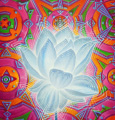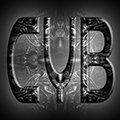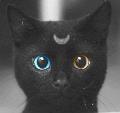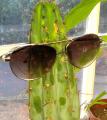
DMT-Nexus member

Posts: 2277 Joined: 22-Dec-2011 Last visit: 25-Apr-2016 Location: Hyperspace Studios
|
So here we pick up where we left off in this thread: https://www.dmt-nexus.me...osts&m=406773#406773...Where we combine digital and analog techniques to create hybrid multimedia art. The idea with this project is to show a few straightforward Photoshop tricks that will allow you to take your drawings (pencil, charcoal, marker, whatever you want) and go to some entirely new places with them. I've created this with newer Photoshop users in mind. The techniques I'm showing here are kind of unorthodox, a little down-and-dirty. It's the opposite of how a meticulous digital graphic artist would probably work. But it's fast, flexible, and appeals to my painter's approach. What you're seeing here took about 2 hours, including Photoshop, typing and a bowl break. Note: You can do this stuff with a mouse, but seriously, do yourself a favor and buy the $89 Wacom tablet. For this thread I'm using a drawing that was volunteered by Cosmic Learning (Thanks C.L.!) and so will be a collaboration when finished. In Fig.1 is the photo he sent me; Fig 2 is what I did to it with Levels in Photoshop (Command/L). the purpose was to darken the whole thing to a nice medium gray, a deep enough shade to lift some meaningful highlights from. Shadows were darkened a bit too. After that, I duplicated the layer (Layer/Duplicate layer) and selected the top layer in the Layers Palette, for reasons that I'll go into shortly. Next, I selected the Dodge Tool (the black lollipop thing in the Tool Palette), set it to Highlights in the Options Bar, gave it a nice big diameter and soft feather, and used that to lift up large light areas throughout the piece (Fig. 3). I then went to a smaller diameter and used it to work the detail, in particular bringing out textures in the foreground figure (Fig. 4). Next, in the same dropdown box as the Dodge Tool is the Burn Tool (the white hand thing), set to Shadows in the Options Bar, which is then used to darken the shadows and outlines throughout the piece (Fig. 5). After that, an eraser is used to clean up any overspray from the large brushes, such as in Fig. 6-7, where you can see part of the background that was inadvertently lightened by the Dodge Tool. By using a small sharp-edged eraser, this area can be cleaned up, revealing the unaltered layer underneath, as in Fig. 8. With the piece all cleaned up, the two layers can be merged (Command/E). We now have our finished basic value work. Guyomech attached the following image(s):  Fig.1-2.jpg (161kb) downloaded 212 time(s). Fig.3-4.jpg (207kb) downloaded 211 time(s). Fig.5-7.jpg (166kb) downloaded 215 time(s). Fig.8.jpg (103kb) downloaded 213 time(s).
|
|
|
|
|

DMT-Nexus member

Posts: 2277 Joined: 22-Dec-2011 Last visit: 25-Apr-2016 Location: Hyperspace Studios
|
Next comes color. This is begun by duplicating the bottom layer twice (Layer/Duplicate Layer, Layer/Duplicate Layer). Next, the top layer is selected in the Layers Palette, and then changed using Selective Color (Fig. 9). In the control window for this filter you can see that I selected Neutrals, since gray is the dominant shade, and then added black to darken the whole thing. I then dropped most of the yellow and added cyan and magenta, which created a nice deep purple. Next, I turned off the top layer in the Layers Palette and selected the middle layer, then went back to Selective Color. Again I selected Neutrals and added some black, but then I dropped out most of the cyan and boosted the magenta to get a nice red color (Fig. 10) Next, time to start combining colors: After turning the purple layer back on and selecting it in the Layers Palette, I used an eraser with a sharpish edge and a medium diameter, set to around 40% opacity, to pull some of the red through the purple by carefully erasing some of the purple (Fig. 11). By using a low opacity and careful overlapping strokes, a lot of control over variation in the opacity can be achieved. Keep in mind that you can increase and decrease the diameter of your brush by hitting the [ and ] keys. Once the background colors are more or less where I want them, these layers are merged by selecting the top layer and clicking Command/E. After that, the eraser, mostly set to 100% opacity, is used to clear out the central figure, removing all background colors. As an afterthought, a layer of mist is added; for this I first created a new top layer (Layer/New Layer), a sea foam green gradient is added using the Gradient Tool, then the layer is set to a low opacity and the bottom area cleared out using a very large eraser with the softest feather (Fig. 12). I then went back to the color layer, chose the Magic Wand Tool from the Tool Palette, and then clicked inside the figure. This selected the area that had been cleared with the eraser; I then went back to the mist layer and hit the Delete key, which cleared out the mist inside the selection (Fig. 13). After Deselecting, I did some final work in the mist layer with the eraser just to smooth it out (Fig.14). Guyomech attached the following image(s):  Fig.9-10.jpg (199kb) downloaded 212 time(s). Fig.11-12.jpg (165kb) downloaded 210 time(s). Fig.13-14.jpg (241kb) downloaded 209 time(s).
|
|
|

DMT-Nexus member

Posts: 2277 Joined: 22-Dec-2011 Last visit: 25-Apr-2016 Location: Hyperspace Studios
|
Now we move to the figure: First the bottom layer is duplicated twice again, then the top duplicate is taken into Image/Selective color and changed to a crazy green color (Fig. 15). That layer is turned off, the one below that is selected and turned pink (Fig. 16). The green layer is turned back on and selected, then the eraser is used to reveal some of the pink (Fig. 17). The green and pink layers are then merged (Command/E), and the bottom layer turned to a deep indigo in Selective Color. The pink/green layer is then erased inside the eye to reveal the indigo, as in Fig. 18. That's about all the coloring we'll do with Selective Color. Just for fun, I try the Plastic Wrap filter next. To do this, first the pink/green layer and indigo layer are merged (Command/E), duplicated (Layer/Duplicate Layer) and the top one selected. Then we go to Filter/Artistic/Plastic Wrap, and play around with the parameters until there are some fun and usable textures (Fig. 19). The eraser is then used to very selectively remove any plastic wrap parts that aren't wanted, using overlapping strokes at around 40% opacity for optimum control (Fig. 20). Then I decide the greens need some selective warming; for this, I merge the plastic wrap and non-plastic wrap layers, duplicate the resulting layer, turn off the top one, select the bottom one, and go to Hue/Saturation (Command/U, Fig. 21). Here I slide the hue around until the greens take on the warmer tone I'm looking for. After that, I turn the upper creature layer back on, then use the eraser to selectively bring out some warmer areas, before finally merging those layers together (Fig. 22). Guyomech attached the following image(s):  Fig.15-16.jpg (217kb) downloaded 209 time(s). Fig.17-18.jpg (208kb) downloaded 207 time(s). Fig.19.jpg (232kb) downloaded 209 time(s). Fig.20.jpg (166kb) downloaded 209 time(s). Fig.21-22.jpg (202kb) downloaded 210 time(s).
|
|
|

DMT-Nexus member

Posts: 2277 Joined: 22-Dec-2011 Last visit: 25-Apr-2016 Location: Hyperspace Studios
|
Finally comes the airbrush work. First I created a new layer called CreatureColor as the top layer (Layer/New Layer). After selecting this layer I used a large, soft-edged airbrush to quickly brush in the big light and dark gradients, without worrying about overspray onto the background (Fig. 23). The color is selected by holding down the Option key and clicking anywhere in the image, or you can click in the color box at the bottom of the Tool Palette to choose a color that way (Option key is faster but only provides colors that are already on the canvas). After that, a medium-sized sharpish edged eraser, set at 100% opacity, is used to clean up the overspray (Fig. 24). What's left is a great foundation for working with a smaller airbrush, set to medium sharp at 4-6 pixels, around 50-75% opacity. For this, it's best to zoom in a little (Fig. 25), either by using the magnifying glass or by hitting Command/+ (you can zoom back out with Option/Magnifying Glass, or Command/-). The small brush is then used for detail, highlights, cleanup and other effects. Often it's best to be selective rather than working the whole surface with the same amount of detail (Fig. 26). Once the airbrushing is done, I return to the colored cavern layer, tweak the hue and saturation (Fig. 27) and then do a Gaussian Blur, which is great for pushing things into the background, as in Fig. 28. The finished image was quick and simple to do, but has color, two levels of focus, areas of detail and highlight, along with some other fun effects (Fig. 29). There you go... hopefully you get the idea. If anyone has any questions, please ask me in this thread. Guyomech attached the following image(s):  Fig.23-24.jpg (181kb) downloaded 204 time(s). Fig.25-26.jpg (200kb) downloaded 201 time(s). Fig.27-28.jpg (205kb) downloaded 203 time(s). Fig.29.jpg (177kb) downloaded 207 time(s).
|
|
|

LUVR
Posts: 1331 Joined: 24-Aug-2010 Last visit: 17-Jan-2024 Location: Thither
|
Great tutorial Guyo! Thanks a million for this, I know I am going to be on this thread a lot in the next couple days trying to get the hang of digital painting. The one thing I don't fully understand is this part: Guyomech wrote:Finally comes the airbrush work. First I created a new layer called CreatureColor as the top layer (Layer/New Layer). After selecting this layer I used a large, soft-edged airbrush to quickly brush in the big light and dark gradients, without worrying about overspray onto the background (Fig. 23). Are you just adding soft whites and blacks/grays to the areas that are already highlighted and shadowed to smooth them out a bit more? 'Little spider weaves a wispy web, stumblin' through the woods it catches to my head. She crawls behind my ear and whispers secrets. Dragonfly whiz by and sings now teach it.'
|
|
|

DMT-Nexus member
 
Posts: 3574 Joined: 18-Apr-2012 Last visit: 05-Feb-2024
|
That's a nice looking tutorial Guy...those late nights and ug's are working wonders...  Great looking alien too. Please do not PM tek related questions Reserve the right to change your mind at any given moment.
|
|
|

DMT-Nexus member

Posts: 2277 Joined: 22-Dec-2011 Last visit: 25-Apr-2016 Location: Hyperspace Studios
|
Wax- that's exactly what's going on there... Although the same method can be used to shade or color an object that is still at a very simple stage, like just an outline. The point is that you use a big brush to keep this stage of shading and coloring smooth, and use the eraser to clean up the overspray. This can also be achieved with masks, but in many cases this is a more direct approach with fewer steps.
|
|
|

DMT-Nexus member
Posts: 77 Joined: 28-Nov-2012 Last visit: 29-Nov-2013 Location: somewhere between there and nowhere
|
Awesome! Honored to have you playing with my sketches  lol Can't wait to try these techniques out. I doubt my version will look quite as clean but well see! I tried doing some of this last weekend when I had some time but kept forgetting to make duplicate layers so when I messed something up it was really hard to go back and fix :/ I live in Aruba with Elvis and Makaveli. We produce sick beats all day and make up silly stories on the internet. All of my stories are fictitious, must be all the second hand pot smoke from Tupac.
|
|
|

DMT-Nexus member
 
Posts: 3574 Joined: 18-Apr-2012 Last visit: 05-Feb-2024
|
Cosmiclearning wrote:but
kept forgetting to make duplicate layers so when I messed something
up it was really hard to go back and fix :/ Yeah...if in doubt...add another layer and remember you have 30 or more points of History to go back with.(change in prefs) If your layer looks right and finished...ctrl E will merge it with the one below... Also ctrl Z for emergency undo's...  And don't forget to hit Save now and again....you will be glad if the power craps out or the cat sits on the keyboard. Oh and backup...backup...backup...backup...! x10  Please do not PM tek related questions Reserve the right to change your mind at any given moment.
|
|
|

DMT-Nexus member
Posts: 77 Joined: 28-Nov-2012 Last visit: 29-Nov-2013 Location: somewhere between there and nowhere
|
Thank you! I'm so new to all this digital stuff I live in Aruba with Elvis and Makaveli. We produce sick beats all day and make up silly stories on the internet. All of my stories are fictitious, must be all the second hand pot smoke from Tupac.
|
|
|

DMT-Nexus member

Posts: 2277 Joined: 22-Dec-2011 Last visit: 25-Apr-2016 Location: Hyperspace Studios
|
Duplicate layers are a great insurance. Duplicate files can be even better...
|
|
|

DMT-Nexus member
Posts: 1925 Joined: 28-Apr-2010 Last visit: 07-Jul-2024
|
Awesome work Guy! Thank you so much for taking the time to put this together. This will come in handy for me in the very near future hopefully. Convert a melodic element into a rhythmic element...
|
|
|

DMT-Nexus member
Posts: 1310 Joined: 27-Sep-2012 Last visit: 01-Feb-2022 Location: Lost in space
|
Thank you for putting this together, Guy! I hope I can get into this soon, but I broke my damn computer screen. I have some drawings that will be perfect for this! I can't wait! Be an adult only when necessary.
|
|
|

DMT-Nexus member
Posts: 1310 Joined: 27-Sep-2012 Last visit: 01-Feb-2022 Location: Lost in space
|
Good news first, my wacom tablet is in the mail! I'm pretty jacked up to finally get working with it. Now for my question, I've read through this a time or two. I think I can figure out most of the stuff, but I have one question about the layers. When it comes to color, do you have each shade of color on different layers (as in, a layer from reds, one for blues and one for yellows), or is it just kind of which layers work best with the colors? I'm as new as possible to PS, so the layers thing is a bit of a mystery. I should be able to figure it out by messing around a bit, but any help is greatly appreciated! Be an adult only when necessary.
|
|
|

DMT-Nexus member

Posts: 2277 Joined: 22-Dec-2011 Last visit: 25-Apr-2016 Location: Hyperspace Studios
|
It'll make sense once you get started. You can have as many layers as you want. Think of each of them as being a sheet of transparent acetate that you can draw or paste stuff onto. Then you can change things in that layer without affecting the other ones. I could go on for fifty pages about layers, but for starters try messing around a little and let me know where you need help. Congrats on the tablet! (give yourself a week or two to get the feel for it)
|
|
|

DMT-Nexus member
 
Posts: 3574 Joined: 18-Apr-2012 Last visit: 05-Feb-2024
|
Also Ctrl U will be your new colourful friend...  Please do not PM tek related questions Reserve the right to change your mind at any given moment.
|
|
|

DMT-Nexus member
Posts: 1310 Joined: 27-Sep-2012 Last visit: 01-Feb-2022 Location: Lost in space
|
Thanks guys! Hopefully I'll have something cool to post up in a week or two (possibly more, but I'm a quick learner). Be an adult only when necessary.
|
|
|

DMT-Nexus member

Posts: 2277 Joined: 22-Dec-2011 Last visit: 25-Apr-2016 Location: Hyperspace Studios
|
Look up "photoshop keyboard shortcuts". Ctrl/U is hue/saturation, very useful. Ctrl/L is Levels, which tweaks brightness and contrast (play with all the sliders, see what they do). Ctrl/B is Color Balance, where you can slide from warm to cool etc. The list goes on and on and on. Oh yeah, ctrl/Z is Undo... Be prepared to use it a lot. Click it over and over and it will undo/redo/undo/redo, which lets you evicted a change you just made to see if its an improvement or not.
|
|
|

Life is Art is Life
Posts: 697 Joined: 11-Sep-2012 Last visit: 13-Apr-2016 Location: watching the wheels go round and round
|
Ctrl/U is my favorite shortcut in all of Photoshop!!! Also, in newer versions Redo is actually Ctrl/Y so Ctrl/Z-Ctrl/Y = Undo/Redo. My main complaint about PS is when the change keyboard shortcuts from one version to the next. Takes me a while for my fingers to unlearn/relearn the ones I use a lot. Images of broken light,
Which dance before me like a million eyes,
They call me on and on...
|
|
|

DMT-Nexus member
 
Posts: 3574 Joined: 18-Apr-2012 Last visit: 05-Feb-2024
|
Used an awful lot are:Ctrl A - Select All Ctrl C - Copy Ctrl V - Paste Ctrl X - Cut Ctrl Z - Undo Ctrl O - Open Ctrl T - Transform Ctrl W - Close Ctrl I - Invert Ctrl ; - Show guides Ctrl L - Levels Ctrl U - Hue/Saturation Ctrl E - Drop layer down one Ctrl - & = Image Size (on screen) [ & ] Brush size up & down Shift f5 - Fill Tab - Hide tools Ctrl+Backspace - Fill with Background Color Alt+Backspace - Fill with Foreground Color And most importantly Ctrl S - Save Soo many more...if you master as many as possible...the workload diminishes immeasurably...  Attached a full list.. Please do not PM tek related questions Reserve the right to change your mind at any given moment.
|